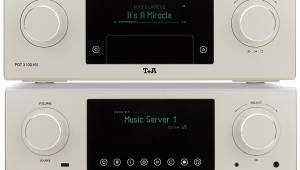Primare Cd32 (£2200)

Replacing the CD31, this new CD32 has been designed alongside the I32 integrated Class D amplifier [HFN Jun ’11]. Sweden’s Primare company has always had an eye for handsome design and while the appearance of these latest 32 models is broadly the same as the products they supersede, each component has been enhanced by the inclusion of a white-coloured, variable-brightness organic electroluminescent display (OLED) panel that adds real finesse.
The CD32 is housed in an alloy/steel chassis and is beautifully finished; balanced outputs match the balanced inputs of its partnering amplifier. Separate PCB modules featuring SMDs are used to isolate signal paths while keeping them as short as possible, a regulated power supply employing an R-core transformer with separate windings for mechanical, analogue and digital audio circuits, while a separate switch mode supply powers the player’s microprocessor.
Its multi-bit DAC comprises two Burr-Brown PCM1704s (with DF1706 digital filter), used with a SRC4392 sample rate converter that can be switched between 44.1, 48 and 96kHz via the remote handset.
RAZOR SHARP
The Vivaldi sounded crisp and vivid, the CD32 preserving the fast-edged transients of the instruments and providing an open window through which to observe the musicians spread across the soundstage. While subjectively less sweet than the Marantz SA-KI Pearl Lite and a bit more forward-sounding, it delivered a razor-sharp image that was highly explicit. The CD32’s up-front balance was noticed again with Patricia Barber’s ‘Bye Bye Blackbird’ where her intimate vocal appeared more forward in the mix – this was judged to be a subjective consequence of the player’s extraordinary clarity.
Compared with the other players in this group the Primare sounded quite stark, with inky-black space around the musicians that helped produce a holographic sound image. The brushes on the snare drum and hi-hat were extremely authentic, bass was deeply extended, and the piano sounded explicit as the tails of reverb faded to silence around each note during the jazz solo.
I expected the energetic Pink Floyd and, especially, Adele’s effervescent track to sound spiky given this explicitness – yet it didn’t. Sure, it doesn’t gloss over imperfections in recordings, but its clarity proved exhilarating.
Originally published in the July 2011 issue





















































